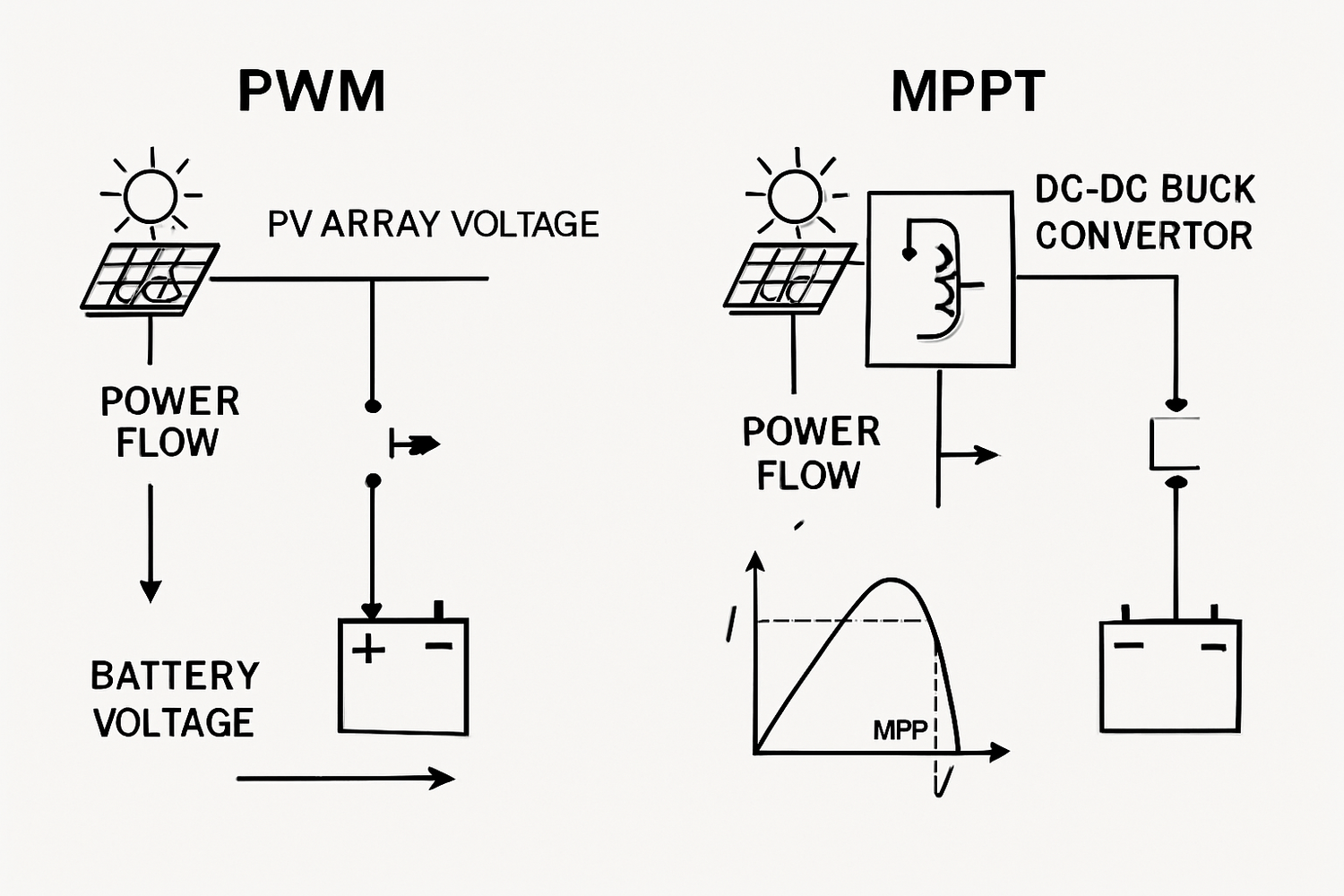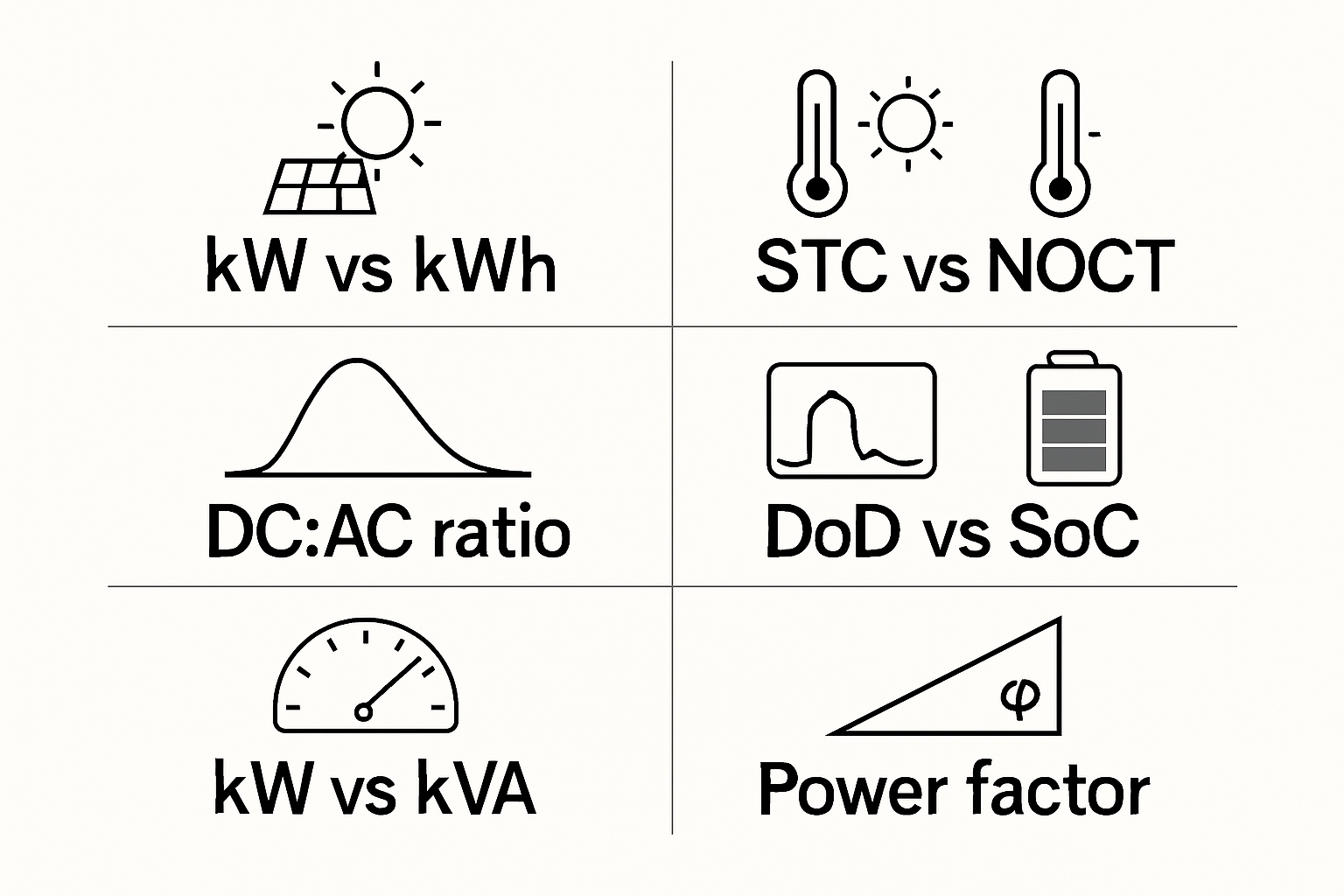Picking between MPPT and PWM affects energy yield, wiring, and long‑term costs. This piece gives a clear MPPT vs PWM comparison with real numbers, simple tables, and sizing steps you can apply to off‑grid cabins, RVs, and hybrid ESS. You will see where each controller fits, how climate shifts the outcome, and what to check to avoid mis‑matches that burn kWh every day.

How each controller works
PWM: voltage clamping and simplicity
A PWM solar charge controller is a high‑speed switch that connects the PV array directly to the battery during charging pulses. The array is forced to operate near the battery voltage. That keeps cost down, but it leaves power on the table if the panel’s optimal operating voltage (Vmp) is higher than the battery voltage.
- Typical use: small 12 V or 24 V systems with panels whose Vmp closely matches the battery voltage.
- Pros: low cost, minimal electronics, robust.
- Trade‑offs: less energy in cool weather, shaded or mixed arrays, or any setup with PV Vmp much higher than battery voltage.
MPPT: tracking the sweet spot and converting power
An MPPT solar charge controller runs a DC‑DC converter that continuously finds the panel’s maximum power point (near Vmp, Imp). It converts higher PV voltage down to battery voltage while increasing current, so power transfer is close to the panel’s potential.
- Typical use: medium to large arrays, higher string voltages, long wire runs, colder climates, or anytime efficiency matters.
- Pros: 10–30% higher harvest vs PWM in many field conditions; supports higher PV voltage and thinner cables.
- Trade‑offs: higher price; needs correct sizing for PV voltage, battery voltage, and current.
Modern PV and power‑electronic controls are software‑driven. As noted in System Integration of Renewables, software control enables tailored responses and better system performance. On the DC side, MPPT is a direct application of that idea: track the optimal point and convert it efficiently.
Real numbers: energy yield in common setups
The math below uses typical STC values. Field results vary with irradiance, temperature, wiring, and controller efficiency, but the patterns hold.
Case A: 12 V battery + 200 W panel (Vmp 18 V, Imp 11.1 A)
- PWM: Battery bulk voltage about 13.8 V. Power to battery ≈ 11.1 A × 13.8 V ≈ 153 W.
- MPPT: Panel power ≈ 200 W; with 97% conversion ≈ 194 W delivered.
Gain: roughly 27% in this simple match‑but‑not‑perfect scenario.
Case B: 24 V battery + two 400 W modules (each ~Vmp 34 V, Imp 11.8 A)
- Series string Vmp ≈ 68 V, Imp ≈ 11.8 A, array power ≈ 800 W. A PWM controller will clamp to battery voltage, so current cannot exceed ~11.8 A. Battery at ~28.8 V absorb → ≈ 339 W. The rest is wasted as the array is pulled off its MPP. Many PWM units also have low PV‑voltage limits, so this setup is often not recommended.
- Parallel wiring Vmp ≈ 34 V, Imp ≈ 23.6 A. PWM harvest ≈ 28.8/34 ≈ 85% of array power → ≈ 680 W. MPPT would be near 800 W × 0.97 ≈ 776 W.
Gain vs PWM (parallel): ≈ 14% (and more in cold weather).
Temperature and partial shade effects
- Cold boosts panel voltage. MPPT benefits because it can exploit higher Vmp; PWM cannot rise above battery voltage, so the gap widens on cold, clear days. Energy.gov’s solar topic pages (Solar Energy) describe how temperature shifts PV electrical behavior.
- Partial shading shifts the I‑V curve and can create multiple local peaks. MPPT algorithms track the most productive point, while PWM has no search capability.
Side‑by‑side MPPT vs PWM comparison
| Aspect | PWM | MPPT |
|---|---|---|
| Energy harvest | Lower if PV Vmp > battery V; typically 70–90% of array rating depending on match | Higher; 95–99% converter efficiency, tracks true MPP |
| PV voltage range | Best near battery voltage; high PV voltage wastes energy | Wide input range enables longer strings and thinner cables |
| Cold‑weather gain | Limited | Significant, thanks to higher Vmp in cold |
| Shade response | No active tracking | Active tracking can find better operating points |
| Cost | Lower | Higher |
| System size fit | Small, budget systems; close PV‑battery voltage | Medium–large arrays; mixed modules; long runs; hybrid ESS |
The benefits of electronics and smarter controls are echoed in grid studies. The IEA notes that modern renewable plants are software‑controlled and can be tuned to improve stability and performance (Getting Wind and Solar onto the Grid; System Integration of Renewables). On a smaller DC system, MPPT plays the role of maximizing usable PV energy so downstream devices have more to work with.
How to choose a solar charge controller
1) Match PV format to battery voltage
- If you use 36‑cell or small 12 V “nominal” panels on a 12 V battery, PWM can be acceptable for tight budgets.
- Standard 60/120 or 72/144 half‑cut modules have Vmp ~30–40 V. On 24 V or 12 V batteries, MPPT avoids the voltage mismatch loss and supports series strings.
- Check the controller’s maximum PV Voc rating under the coldest site temperature. Voc rises as temperature drops. This is a common sizing miss. The IEA highlights temperature‑related line and equipment ratings in transmission planning; the same principle applies at small scale for safe margins (Getting Wind and Solar onto the Grid).
2) Consider climate and shade
- Colder sites: MPPT gains increase. Expect double‑digit percentage gains over PWM for much of the year.
- Hot sites: the gap narrows but MPPT still helps with long wires and higher PV voltages.
- Complex roofs or partial shade: MPPT performs better thanks to tracking. String planning still matters.
3) Battery chemistry and charge profile
- LiFePO4 needs precise charge stages and current limits enforced by the BMS. Quality PWM and MPPT both support custom profiles, but MPPT offers finer control at higher currents.
- Lead‑acid benefits from temperature compensation and absorption timing. Both types can handle this; MPPT helps finish charges faster on variable days.
4) System type and scalability
- Small off‑grid loads (lighting, small pumps): PWM can be fine if panels match battery voltage closely.
- Expandable cabins, farm sites, or hybrid ESS with integrated inverters: MPPT supports higher DC power, longer strings, and cleaner wiring. IEA work on integrating variable renewables stresses the value of modular, controllable subsystems to maintain performance as systems scale (System Integration of Renewables; Integrating Solar and Wind).
Cost vs energy: quick payback check
Estimate your net gain in kWh per year and compare to the controller price difference.
- Example: 1 kW array, 24 V battery, 4 peak sun hours average → ~1,460 kWh/year DC. With PWM (voltage mismatch to 60‑cell modules), assume 85% harvest → ~1,241 kWh. With MPPT at 97% → ~1,416 kWh. Gain ≈ 175 kWh/year.
- If displaced energy value is $0.20/kWh (diesel offset or grid value), annual benefit ≈ $35. If the MPPT premium is $200, simple payback ≈ 5.7 years. In colder sites or with longer wire runs, gains are higher, payback shorter.
| Array size | Assumed PWM loss vs MPPT | Extra kWh/year with MPPT | Value at $0.20/kWh |
|---|---|---|---|
| 500 W | 12% | ~88 | $18 |
| 1 kW | 12% | ~175 | $35 |
| 2 kW | 12% | ~350 | $70 |
These are ballpark figures. Real numbers depend on temperature, wiring, shading, and controller quality. Agencies like IRENA show that better yield lowers lifetime energy cost, which supports MPPT in most medium and large systems.
Wiring, ratings, and safety notes
Electrical work can be hazardous. Follow local codes and equipment manuals. This is not legal or electrical advice.
- Check controller limits: PV Voc max, PV Isc max, battery charge current, and temperature derating. Size conductors for current and voltage drop, and protect with fuses or breakers.
- Cold‑weather Voc: calculate worst‑case Voc at the site’s minimum temperature before selecting series string length. The IEA’s grid reports highlight how temperature drives equipment ratings; apply that discipline at the array level too (Getting Wind and Solar onto the Grid).
- System integration: hybrid inverters with built‑in MPPT simplify balance‑of‑system components. EIA and IEA track rising distributed PV; coordinated controls help ensure safe, stable operation as penetration grows (EIA; Integrating Solar and Wind).
Where each choice fits
- PWM fits budget builds with small loads and panels matched to battery voltage, short wire runs, and warm climates.
- MPPT fits mixed or modern modules, longer strings, colder climates, partial shade, growth plans, and integrated ESS with lithium batteries.
Our team focuses on lithium batteries (LiFePO4), integrated ESS, off‑grid solutions, and inverters. In practice, MPPT pairs well with LiFePO4 because it keeps current high at proper voltage, shortens bulk time, and respects BMS limits.
Key takeaways
- If PV Vmp is significantly higher than battery voltage, choose MPPT.
- In cold sites or with long cable runs, MPPT’s gain rises and wiring gets easier.
- PWM still makes sense for small, matched, cost‑sensitive systems.
IEA research points to the value of controllable electronics in renewable integration (System Integration of Renewables). At the array scale, MPPT is the practical way to capture that value.
FAQ
Is MPPT always better?
No. MPPT wins most cases, but PWM can be a smart pick for small systems using panels designed for the battery voltage, short wires, and tight budgets.
Can PWM work with LiFePO4?
Yes, if the controller supports a correct LiFePO4 profile and current limits. MPPT still charges faster in many real conditions due to higher harvest.
How do I size an MPPT controller?
Check max PV Voc at the coldest temperature, max PV short‑circuit current, and max charge current to the battery. Leave margins as per the manual. Use series strings within the voltage limit. For shaded roofs, consider parallel strings with adequate fusing.
Can I mix MPPT and PWM on the same battery?
It is possible with separate PV sub‑arrays if each controller has its own PV input and both use the same battery charge setpoints. Keep wiring short and well fused.
Does grid integration research matter to small systems?
Yes. Principles are similar: controllable power electronics improve stability and yield. The IEA’s Integrating Solar and Wind and System Integration of Renewables show how better control boosts performance at scale. MPPT applies that logic locally.
Disclaimer: Technical content is for general information only and is not legal, code, or engineering advice. Always follow local regulations and manufacturer documentation.





Leave a comment
All comments are moderated before being published.
This site is protected by hCaptcha and the hCaptcha Privacy Policy and Terms of Service apply.